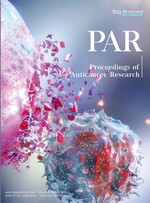Abstract
Objective: To investigate the mechanism of long non-coding RNA SNHG7 and its regulatory effect on the proliferation, migration, and epithelial-mesenchymal transition of cholangiocarcinoma cells. Methods: A total of 20 pairs of cholangiocarcinoma and adjacent non-tumor bile duct tissues were collected from patients with cholangiocarcinoma who underwent surgery in the Affiliated Hospital of Hebei University (Hebei, China). Cholangiocarcinoma cell lines CCLP-1, QBC939, RBE, and HCC-9810 as well as normal human biliary epithelial cell line HIBEC were purchased for cell culture. We performed cell transfection, quantitative real-time polymerase chain reaction (qRT-PCR) to detect gene expression, Cell Counting Kit-8 (CCK-8) experiment to determine cell proliferation ability, scratch test to determine cell migration ability, and Transwell test to detect cell invasion ability. Results: The expression of lncRNA SNHG7 in cholangiocarcinoma cell lines CCLP-1, QBC939, RBE, and HCCC-9810 was 3.21 ± 1.01, 3.03 ± 1.02, 2.98 ± 1.21, and 3.12 ± 1.14, respectively, while its expression in normal cell line HIBEC was 3.21 ± 1.21; the expression of lncRNA SNHG7 in CCLP-1 was the highest; compared with HIBEC, the p values were all less than 0.05, indicating that the difference was statistically significant. The expression of miR-520f-3p in CCLP-1, QBC939, RBE, and HCCC-9810 was 1.45 ± 0.75, 1.55 ± 0.71, 1.54 ± 0.73, and 1.61 ± 0.72, respectively, while its expression in normal cell line HIBEC was 3.21 ± 1.21; the expression of miR-520f-3p in CCLP-1 was the lowest, and compared with HIBEC, the p values were all less than 0.05, indicating that the difference was statistically significant. In qRT-PCR, the expression of lncRNA SNHG7 of si-NC (3.21±1.11) was significantly higher than that of si-SNHG7 (1.14±0.76), and the p value was less than 0.05, indicating that the difference was statistically significant. In the CCK-8 experiment, the proliferation ability of CCLP-1 cells of the si-NC group at 24 h, 48 h, and 72 h was 0.61±0.59, 0.75±0.68, and 1.36±0.71, respectively; the proliferation ability of CCLP-1 cells of the si-SNHG7 group at 24 h, 48 h, and 72 h was 0.51±0.64, 0.59±0.59, and 0.63±0.61, respectively; there was a significant decrease in the proliferation ability, and the p value was less than 0.05, indicating a statistically significant difference. After 24 h of scratch treatment, compared with the si-NC group, the migration ability of CCLP-1 cells of the si-SNHG20 group was reduced (t = 6.356, P = 0.026). The results of Transwell test showed that the cell invasion ability of CCLP-1 in the si-SNHG20 group was significantly reduced compared with the si-NC group (t = 7.845, P = 0.032). Conclusion: Exploring the gene expression mechanism in relation to the occurrence and development of cholangiocarcinoma is beneficial to future clinical work in terms of diagnosis, treatment, and prognosis. The knockdown of lncRNA SNHG7 can effectively inhibit the proliferation, migration, and invasion of cholangiocarcinoma.
References
Zhang Z, Zeng J, Liu X, et al., 2022, Ribophostin 1 Promotes the Proliferation, Migration and Invasion of Cholangiocarcinoma Cells by Activating the Epithelial-Mesenchymal Transition Signaling Pathway. Military Medicine, 2022: 1–9.
Chen Z, Zhu W, Shen B, et al., 2022, 6-Gingeroneol Inhibits the Proliferation, Migration and Invasion of Intrahepatic Cholangiocarcinoma Cells and Its Mechanism. Journal of Clinical Hepatobiliary Diseases, 38(04): 857–864.
Abulaihaiti, Ma S, Chen M, 2022, Research Progress of CPS1 and Its LncRNA in the Diagnosis and Treatment of Cholangiocarcinoma. Liver, 27(03): 373–376.
Jiang Y, Xia X, Liu W, 2022, The Mechanism of circ_0005230 Affecting the Proliferation and Apoptosis of Cholangiocarcinoma Cells by Targeting miR-548c-3p. Advances in Modern General Surgery in China, 25(03): 180–185.
Zhao X, Sun X, Hou J, et al., 2022, Effects of miR-495-3p on the Proliferation and Invasion of Cholangiocarcinoma Cells by Regulating BUB1 Expression. Journal of Wuhan University (Medical Edition), 2022: 1–6.
Hua L, Yang R, 2022, miR-144 Inhibits the Proliferation and Invasion of Cholangiocarcinoma Cells Through LIS1. Journal of Wuhan University (Medical Edition), 43(01): 45–51.
Guo Z, Liang D, Pei T, 2021, Research Status of Long Non-Coding RNA in Intrahepatic Cholangiocarcinoma. Chinese Journal of Clinical Pharmacology, 37(18): 2511–2514.
Shi W, Wang J, Wang D, et al., 2021, Research Progress of Long Non-Coding RNA and Circular RNA in Cholangiocarcinoma. Cancer Research and Clinic, 33(08): 561–564.
Guan C, Liu L, Shi W, et al., 2021, LncRNASNHG20 Regulates the Proliferation and Invasion of Cholangiocarcinoma Cells Through miR-520f-3p. Chinese Journal of Cancer Prevention and Treatment, 13(04): 389–394.
Wei Z, Ma T, Che X, et al., 2021, Clinical Research of lncRNA MALAT1 Regulating the Invasion and Apoptosis of Human Hepatobiliary Cancer Cells and Affecting the Occurrence and Development of Cholangiocarcinoma. Liver Cancer Journal, 8(02): 26–32.
Yao Y, Jiao D, Chen J, et al., 2021, The Mechanism and Potential Application of Circular RNA in Cholangiocarcinoma. Journal of Hepatobiliary and Pancreatic Surgery, 33(06): 370–374.
Li F, 2021, The Function and Mechanism of Long Non-Coding RNAMNX1-AS1 in Intrahepatic Cholangiocarcinoma, thesis, Chinese People’s Liberation Army Naval Medical University.
Chen J, 2021, LncRNA ZFPM2-AS1 Targets miR-515-5p to Regulate the Proliferation, Migration and Invasion of Cholangiocarcinoma Cells. Hebei Medicine, 43(07): 976–980.
Ren W, 2021, LncRNAMALAT1 Sponge miR-200a-3p Regulates Gab1 Expression and Affects VEGF Autocrine Secretion in Hilar Cholangiocarcinoma Cells, thesis, China Medical University.
Yang B, 2020, Effects of microRNA-133 on the Migration and Invasion of Cholangiocarcinoma Cells, thesis, Qingdao University.
Zou Y, 2020, The Anti-Cholangiocarcinoma Effect of Galangin Mediated by miR-21-5p and Its Mechanism, thesis, Guangxi Medical University.
Jiang Z, 2020, The Function and Molecular Mechanism of miR-181b in the Progression of Cholangiocarcinoma, thesis, Fujian Medical University.
